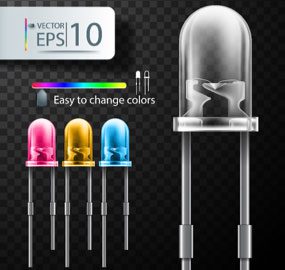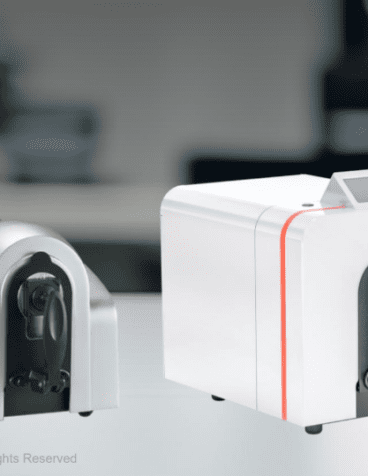By Ken Butts
This post is part of a three-part series. You can find part 2 here and part 3 here.
Color management, LED
Companies worldwide are rapidly adopting LED lighting for its improved energy efficiency and resulting cost savings. But what they may not have considered is how the color of their products will be impacted. The color of a product is directly related to the color of the light source, so the visual experience of designers, merchandisers, suppliers, and ultimately customers will be affected when products are viewed in LED lighting. To ensure a positive customer experience, companies must be proactive in evaluating the implications of a change in light source on the color of their products.
LED’s Impact on Color
 Two important properties must be considered when evaluating the impact of a lighting change: flare; and metamerism. The two properties are similar, but are applicable in different situations. Flare is a term that describes a sample’s tendency to change color when viewed in different light sources. If a sample appears redder in one light source compared to another, we say the sample flares red. This tendency of samples to change color when viewed in different lighting is also referred to as color inconstancy. Most colored materials flare to some degree as the light source changes, and the same will be true when they are viewed in LED lighting. The key question then is whether the change in flare is objectionable, and if so, what must be done to minimize the negative experience.
Two important properties must be considered when evaluating the impact of a lighting change: flare; and metamerism. The two properties are similar, but are applicable in different situations. Flare is a term that describes a sample’s tendency to change color when viewed in different light sources. If a sample appears redder in one light source compared to another, we say the sample flares red. This tendency of samples to change color when viewed in different lighting is also referred to as color inconstancy. Most colored materials flare to some degree as the light source changes, and the same will be true when they are viewed in LED lighting. The key question then is whether the change in flare is objectionable, and if so, what must be done to minimize the negative experience.
Metamerism is a similar property but is applicable when two samples are compared to each other. When the visual color difference between two samples in one light source is not the same when the samples are viewed in a second light source, then we say the sample are exhibiting metamerism. A typical example is when the cuff and sleeve of a jacket appear to be a good match in the store but then look quite different when viewed outside in daylight. A primary goal for textile manufacturers then is to match the standard as closely as possible in all specified light sources, thereby minimizing potential problems due to metamerism.
An Implementation Plan
Prior to the transition to LED, companies must evaluate how their color standards and their existing products are impacted by changes in flare and metamerism, and then decide what if any corrective actions are required. But the severity of the impact may be different depending on who is evaluating the products, so key stakeholders must be considered in the evaluation process:
- Designers: The colors they have selected for their designs may not look the same in LED as they do in their original primary light source, changing the overall aesthetic of the product
- Merchandisers: The seasonal color palette may not be as pleasing, either because the entire palette shifts in color or individual colors flare in an unacceptable direction
- Color office: Communication is key, and the retail/apparel color office is often left with the responsibility of implementation into the global color management workflow
- Suppliers: Existing colors may need to be reformulated to match standards under a new light source, and on-going production may no longer match the standard as well in LED
- Everyone who evaluates color: Color evaluation will require light booths equipped with LED, and software must be updated to calculate color differences in LED, both of which may incur some amount of cost to implement
- Ultimately the customer: The customer experience must still be positive, and support on-going sales of products
The LED implementation plan must consider the impact of the new light source on these stakeholders. There are very specific questions that can be asked to ensure that the visual experience of each of these groups is considered, such as:
- Does the color of my standards change compared to my previous light source, and is it a significant enough issue that I need to do anything about it such as modify my palette or repeat the color matching process?
- Will I have issues of metamerism with existing products or carry-over colors, and if so how do I address that?
- How will I evaluate samples visually as well as instrumentally with LED in the retail/apparel office as well as in the supply chain?
- How can I ensure that visual and instrumental results agree, which is essential for a digital pass/fail program?
- Are there alternatives to switching to LED as a new light source in color development?
- How can I avoid the same problems with flare and metamerism in the future if another new light source is introduced?
Color technology providers can be a very positive source of information and support for the retail/apparel color office as they develop the implementation plan. These include color software providers, spectrophotometer providers, and light booth manufacturers, as they will have insight into what other companies are doing and what the implications of LED are for both visual and instrumental sample evaluation.
Stay tuned for next week’s blog, I will talk more about how to evaluate Flare.
Talk to a Color Expert about the right solution for you >


 Two important properties must be considered when evaluating the impact of a lighting change: flare; and metamerism. The two properties are similar, but are applicable in different situations. Flare is a term that describes a sample’s tendency to change color when viewed in different light sources. If a sample appears redder in one light source compared to another, we say the sample flares red. This tendency of samples to change color when viewed in different lighting is also referred to as color inconstancy. Most colored materials flare to some degree as the light source changes, and the same will be true when they are viewed in LED lighting. The key question then is whether the change in flare is objectionable, and if so, what must be done to minimize the negative experience.
Two important properties must be considered when evaluating the impact of a lighting change: flare; and metamerism. The two properties are similar, but are applicable in different situations. Flare is a term that describes a sample’s tendency to change color when viewed in different light sources. If a sample appears redder in one light source compared to another, we say the sample flares red. This tendency of samples to change color when viewed in different lighting is also referred to as color inconstancy. Most colored materials flare to some degree as the light source changes, and the same will be true when they are viewed in LED lighting. The key question then is whether the change in flare is objectionable, and if so, what must be done to minimize the negative experience.




